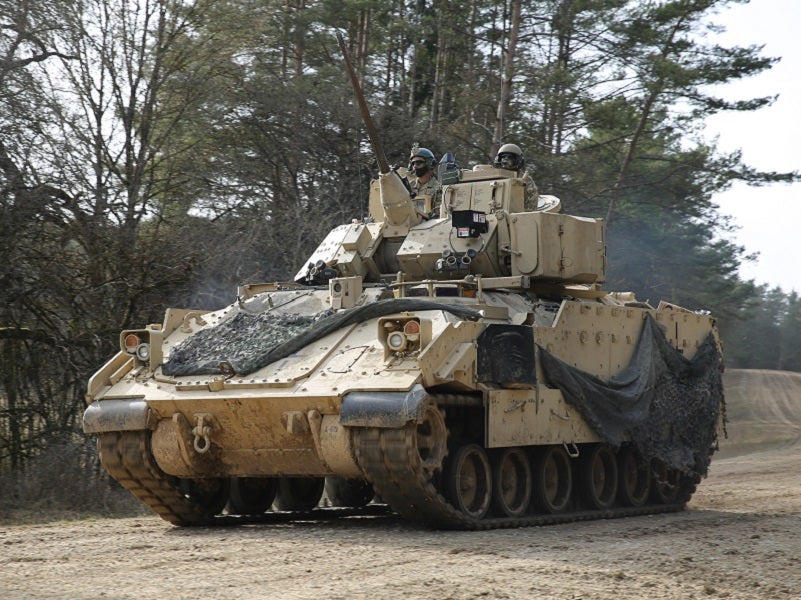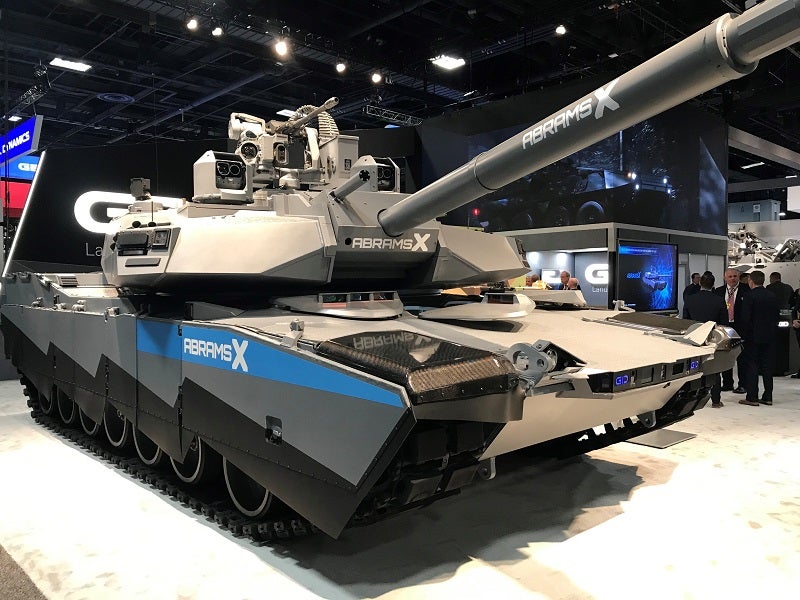
All five contenders for the US Army’s landmark Optionally Manned Fighting Vehicle (OMFV) programme, intended to replace nearly 3,800 Bradley M2 armoured fighting vehicles, look set to opt for a hybrid-electric drive system ahead of industry providing its proposals to the service next month.
In July last year, the US Army awarded contracts to five teams to proceed to the programme’s second stage of the concept design phase. Contracts were awarded to Point Blank Enterprises; Oshkosh Defense; BAE Systems Land and Armaments; General Dynamics Land Systems; and American Rheinmetall Vehicles, totaling nearly $300m.
Speaking during a media roundtable at AUSA 2022 on 11 October, senior US Army officials stated that during concept design activities all potential contenders had presented a hybrid-electric drive system. A hybrid-electric drive could allow for silent manoeuvre and overwatch, both key requirements set by the US Army at the outset of the programme.
As the name suggest, silent overwatch and manoeuvre would permit the vehicle to move at slow speeds on electric drive along, reducing noise output. US Army officials stated however that hybrid drive was not a requirement, rather a desired capability and it was up to industry to determine how best to achieve it.
Other trends seen during the concept design process was a reduction from “larger to much smaller” vehicles, different armour packages, focus on modularity, and track configuration, US Army officials said. The OMFV is also aspiring towards having a two-person crew, likely comprising a driver and vehicle command, incorporating a remote-operated main turret.
OMFV programme outline
According to a May 2022 research paper by the US Congressional Search Service (CRS), the OMFV programme’s phases will see an initial market research and requirement development conducted, with the Phase 2 concept design due to conclude on 1 November.
Once industry has submitted its proposals, contenders will begin to work through the detail design phase to mature the OMFV designs, concluding with a critical design review (CDR). The CRS paper states the completion of a CDR “provides the technical basis for proceeding into fabrication, integration, development, test and evaluation” of the system, and would see the completion of Phase 3 of the programme.
Phase 4 will initiate the prototype build and test phase, verifying prototype performance against listed specifications. Towards the end of this phase a limited user test can be conducted to address a limited number of issues identified during the acquisition process.
The final stage, Phase 5, moves to production and fielding with a single low-rate initial production (LRIP) contract awarded for production, testing, and initial fielding. According to the CRS, it is at this stage when the manufacturing development is completed and also establishes an initial production base, before increasing over time towards full-rate production.
AbramsX pointing towards hybrid future?
In preparation for the future integration of hybrid systems into the US Army, the service has been conducting tests and trials to de-risk as much of the technology as possible and determine operating practices. In addition, two Bradley AFV’s were converted to hybrid drive under a programme with the Rapid Capabilities Office to further test such technologies and integration into US platforms.
Industry is also seemingly taking into account the move towards hybrid drive systems, with General Dynamics presenting its AbramsX at AUSA 2022, showcasing technologies that it thinks could become relevant to future US Army requirements. Included in this was hybrid drive and reduced crew requirements, as is being seen with the OMFV.

Tristan Sauer, land domain analyst at GlobalData, said the AbramsX technology would gain “significant traction” amongst US Army procurement officials.
“The integration of an AI-enabled unmanned turret with an autoloader streamlines operations by reducing the vehicle crew down from four to three while reducing platform weight and providing more room for additional subsystems,” Sauer said.
Sauer details the platform’s hybrid-electric power supply reducing fuel consumption by 50% while also enabling silent watch and silent mobility modes of operation, useful for contested environments.
“AbramsX is also more digitised than its predecessors, as all systems are integrated via the KATALYST Next Generation Electronics Architecture which will greatly facilitate hardware and software upgrades throughout the platform’s life cycle. This creates opportunities for industry partners to develop and market innovative capabilities for the future main battle tank market.
Sauer said the AbramsX also features several technologies that are being integrated throughout the US Army’s vehicle fleets, including active protection systems, augmented reality, crewed-uncrewed teaming, and more. However, the integration of multiple advanced and emerging technologies risks increasing per-unit costs too far to warrant widespread adoption.
“Nevertheless, those advanced features reflect the rapidly evolving nature of modern ground combat, and General Dynamics has demonstrated flexibility and strategic forethought in developing the AbramsX. As the US Army begins to implement the SEPv4 upgrade for its current M1A2 Abrams fleet, the AbramsX may provide the next logical step in the platform’s evolution,” Sauer detailed.
Land vehicle market growth
The global land vehicle market is expected to reach $27.6bn in 2032, driven by increased geopolitical tensions and defence modernisation initiatives, according to GlobalData research. A number of elements are driving this growth, including the US Army’s OMFV effort, as well as its Mobile Protected Firepower programme that will deliver a light tank to US formations.

In Europe, France and Germany are replacing their Leclerc and Leopard 2 tanks through the Main Ground Combat System (MGCS) programme. Similarly, the UK is upgrading its Challenger 2 battle tanks to the Challenger 3 standard, Turkey is manufacturing its indigenous Altay battle tank, and Poland is procuring the M1A1 Abrams tank from the US.




